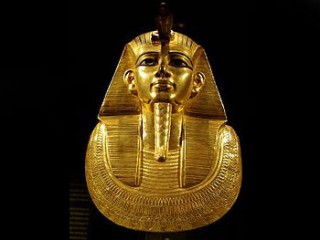
Pierre Montet biography
Date of birth : 1885-06-27
Date of death : 1966-06-19
Birthplace : Villefranche-sur-Saône, France
Nationality : French
Category : Arhitecture and Engineering
Last modified : 2010-08-25
Credited as : Archaeologist and egyptologist, made excavations in Byblos and Tanis, mask of Psousennès mummy - picture on the left
0 votes so far
Tanis had previously been excavated by Auguste Mariette and later by Flinders Petrie in the nineteenth century. In 1939, Montet discovered the tomb of Osorkon II which, although previously looted, contained several significant findings and the door to another, undisturbed tomb. There, Montet found artifacts rivaling those of the greatest discoveries previously made. These findings not only provided inspiration to the academic world and general public alike due to their beauty, but also revealed that kings of these dynasties, the Third Intermediate Period of Egyptian history, were much more successful and wealthy than previously thought, with their tombs rivaling those from the earlier, better known dynasties and those of the final period of the ancient Egyptian civilization.
Early life
Pierre Montet was born in Villefranche-sur-Saône in France. He studied under Victor Loret at the University of Lyon, who did important excavations both outside and within Egypt. After receiving his degree, Montet received professorship of Egyptology at the University of Strasbourg, where he stayed from 1919 to 1948.
Excavations in Byblos
Between 1921 and 1924, Montet directed his first excavations at Byblos (now Jubayl) in Lebanon, discovering tombs of local rulers who were contemporary with Egyptian rulers from Middle Kingdom times. Byblos was famous as one of the oldest continuously inhabited towns in the world. One of the most important findings from Byblos was an alphabetical writing, at the time believed to be the earliest such writing in the world. Montet published his research in his Byblos et l'Égypte in 1928.
Excavations in Tanis
Between 1929 and 1939, Montet excavated at Tanis, ancient Djanet (today San el-Hagar) in the northern-eastern Delta Nile in Egypt. Tanis was founded in the late Twentieth Dynasty, and became the northern capital of Egypt during the following Twenty-first Dynasty. At the time Montet started his diggings, Tanis had already gone through several major excavations—from 1860 to 1880 by Auguste Mariette and from 1883 to 1886 by Flinders Petrie.
In 1939, his eleventh year as the leader of the French archeological team, Montet finally made a great discovery. He found the royal necropolis of the Twenty-first and Twenty-second Dynasty of Egypt—the finds there almost equaled that of Tutankhamun's tomb in the Valley of the Kings. On February 27, he discovered a tomb of a king, identified by inscriptions as Osorkon II. The tomb and its accompanying rooms were already plundered, but Montet managed to uncover a sarcophagus of Osorkon’s son, prince Takelot II. The tomb contained a gold bracelet of Osorkon, as well as a heart scarab, alabaster jars, and other items.
When he cleared the tomb, Montet found the door of another, undisturbed chamber. The inscription mentioned Psusennes I, the third king of the Twenty-first Dynasty who ruled between 1047 and 1001 B.C.E. The tomb was completely intact, with a hawk-headed solid silver coffin belonging to, at that time an unknown king Shoshenq II. The total of the findings rivaled that of Tutankhamun’s tomb, discovered in 1922 by Howard Carter. Unfortunately, due to the moist Lower Egypt location, unlike the dry one in Upper Egypt where Tutankhamun’s tomb was located, most of the wooden objects in the tomb were destroyed by water. However, the king's magnificent funerary mask was recovered intact; it proved to be made of gold and lapis lazuli and held inlays of black and white glass for the eyes and eyebrows.
In addition to the tombs of Osorkon II and Psusennes I, Montet found four more tombs—the occupants of two are unknown and the remaining two belonged to Amenemope and Shoshenq III. Montet opened Amenemope's tomb in April 1940, just a month before the German invasion of France and the Low Countries in World War II. Thereafter, all excavation work abruptly ceased until the end of the war. However, after the war, Montet resumed his activities and proceeded to uncover the intact tomb of General Wendjebaendjed, who served under Psusennes I. Montet described his findings in his La Nécropole royale de Tanis (The Royal Cemetery at Tanis) published in 3 volumes between 1947 and 1960.
Later life
Later in his career, Montet served as professor of Egyptology at the Collège de France, Paris, between 1948 and 1956. He died in Paris on June 19, 1966.
Writings
* Montet, Pierre. 1925. Scenes de la Vie Privee dans les Tombeaux Egyptiens de L'ancien Empire. Paris: Strasbourg University.
* Montet, Pierre. 1928. Byblos et l'Égypte: Quatre campagnes de fouilles à Gebeil, 1921–1922–1923–1924. Paris: P. Geuthner.
* Montet, Pierre. 1937. Les reliques de l'art syrien dans l'Égypte du nouvel empire. Publications de la Faculté des lettres de l'Université de Strasbourg, fasc. 76. Paris: Société d'édition: Les belles lettres.
* Montet, Pierre. 1942. Tanis, douze années de fouilles dans une capitale oubliée du delta égyptien, avec 63 figures et 16 planches hors texte. Paris: Payot.
* Montet, Pierre. [1947] 1960. La Necropole Royale de Tanis, 3 vols. Fouilles de Tanis, ser. ed. Jean Pierre Marie Montet. Paris.
* Montet, Pierre. [1958] 1981. Everyday Life in the Days of Ramesses the Great. University of Pennsylvania Press.
* Montet, Pierre. 1959. L'Égypte et la Bible. Neuchatel: Delachaux & Niestlé.
* Montet, Pierre. 1963. Haiey yom-yom bemitzrayim (La vie quotidienne en Egypte). Am Hassefer Publishers Ltd. Tel Aviv.
* Montet, Pierre. [1964] 2000. Eternal Egypt. Phoenix Press.
* Montet, Pierre. [1968] 1974. Lives of the pharaohs. London: Spring Books.
* Montet, Pierre, Georges Goyon, and Alexandre Lézine. 2006. Les constructions et le tombeau de Chéchang III a Tanis. Worcester, UK: Yare Egyptology.
















